News
Art & Social Change Hosts Community Projects
What does almost everyone from students cramming for tests to veteran teachers have in common at this time of year? Many would answer “stress.” How to combat stress and stressors can take many forms. To that end, last week, Chair of the Visual Arts Department Laura Coppola’s Upper School Art & Social Change class invited students and faculty to participate in interactive community art projects “that seek to address and alleviate some of the concerns and issues in the Poly community” including stress, gender equality, diversity, culture, and recycling. Our students’ projects, born out of collaboration and positivity, brimmed with collective creativity… and yes, some relief!
Stressors in a Scroll
Inspired by the sand mandala created by Buddhist monk Lama Tenzin Yignyen at Poly each year, Owen Wallace ’25 and another student developed their project. Through Stressors in a Scroll, fellow students found a way to symbolically release their stressors.
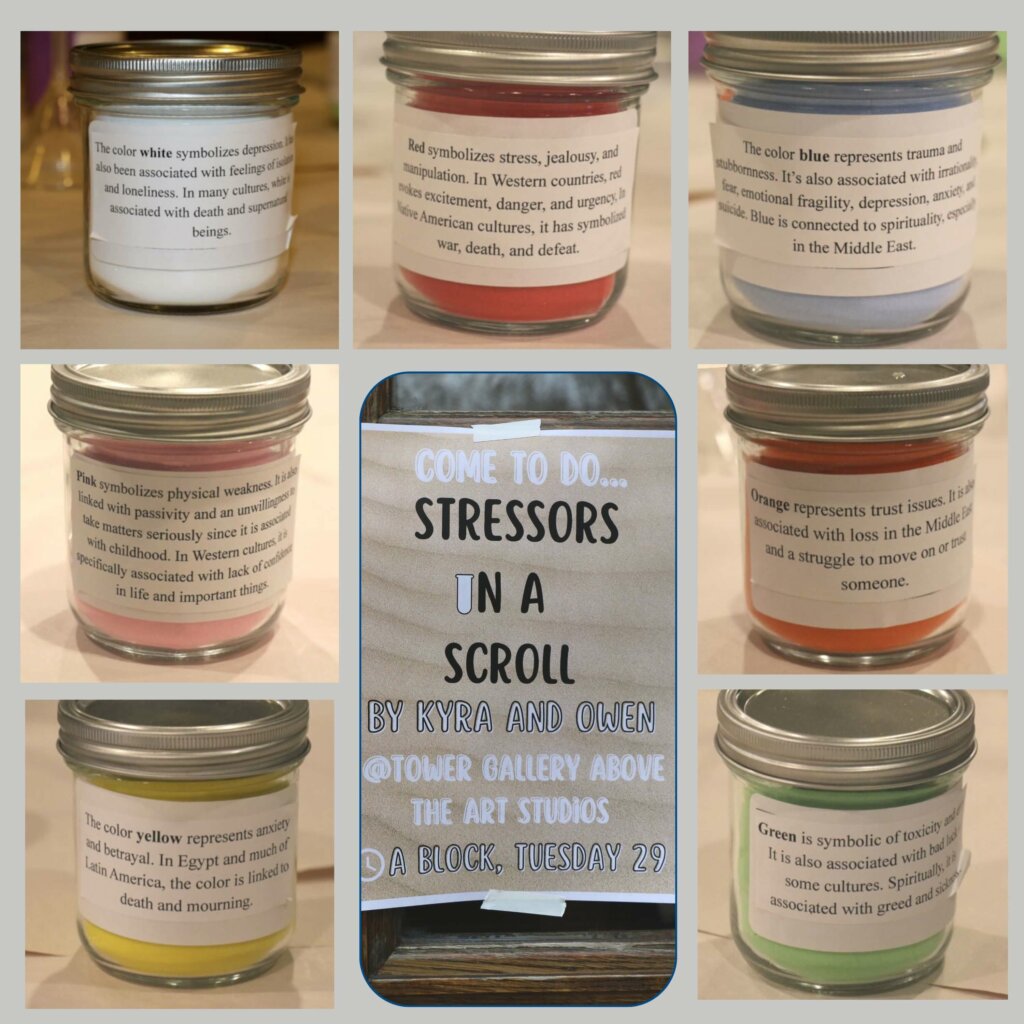
In the Tower Gallery, students were invited to fill a tube with colored sand representing their stressors. Labels on jars of sand explained their significance. White sand symbolizes depression and loneliness and “in many cultures white is associated with death and supernatural beings.” Red symbolizes stress, jealousy, and manipulation. “In Western countries, red evokes excitement, danger, and urgency.” The color blue represents trauma and stubbornness. “Blue is connected to spirituality especially in the Middle East.” Orange represents trust issues and the color is associated with loss in the Middle East. Pink symbolizes physical weakness and in Western cultures “it is associated with lack of confidence in life.” Yellow represents anxiety and betrayal. “In Egypt and Latin America, the color is linked to death and mourning.” Green is symbolic of toxicity.
As students arrived through the Tower Gallery doors, they found tables set up with the jars of colored sand, scrolls, and sharpies. Students were invited to identify an issue that may be causing them stress. On the scroll, they wrote why they chose the color or colors they did and added the scroll to the sand in the tube. Then they poured the sand and scrolls into a glass vase as a symbolic way to release that stress. There were a number of smiles and audible sighs of relief as students headed on to class.

Stress Heat Map
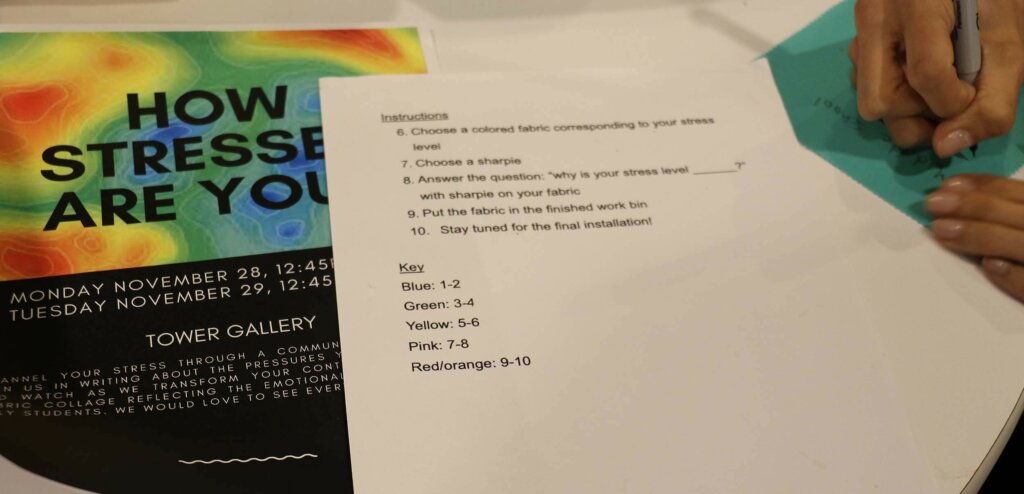
Mila Leonardi ’26 and Olivia Stegich ’26 found a way to turn stress into a work of art. “How stressed are you?” was the question posed by their colorful signs posted in the hallway. They invited the community to write “about the pressures you feel at Poly, and watch as we transform your contributions into a fabric collage reflecting the emotional temperature of Poly students.” In the Tower gallery, participants chose a colored piece of fabric that corresponded to their own stress level from 1-10. Blue for 1-2; green for 3-4; yellow for 5-6; pink for 7-8; and red/orange for 9-10. Two teachers also sat down at the table. One chose a blue fabric and the other a pink. Each wrote on the piece of fabric what was stressing them. The fabric was gathered and would be sewn together into a Stress Heat Map collage to be displayed at the Winter Art Exhibition.
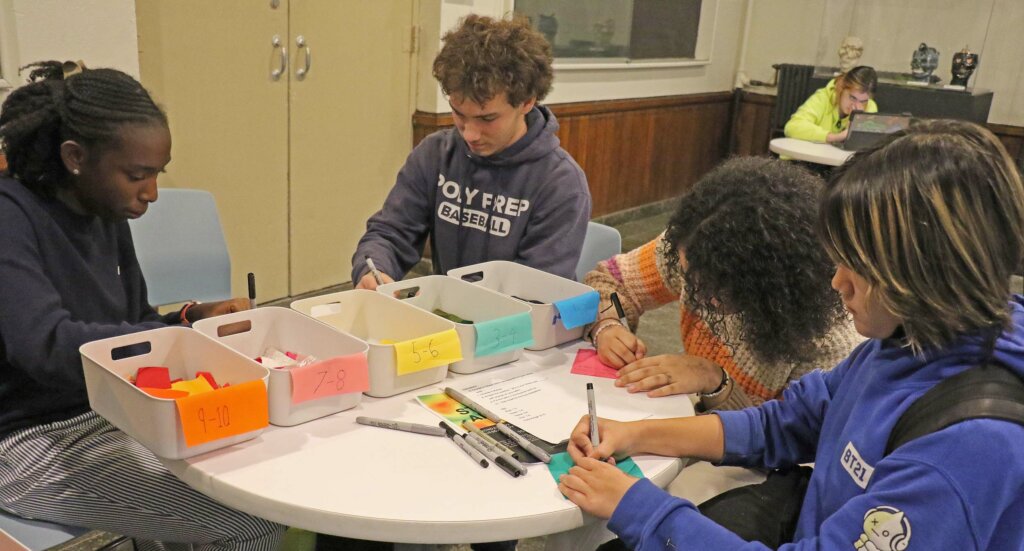
Community Cookbook
For the Community Cookbook, Ijeoma Stanley ’26, Loren Bullen ’26, and Emma Auger-Dominguez ‘26 asked Poly students and faculty to share recipes from their family and culture. The goal was to bring people together through a common ground–food.
“The idea was inspired by a video we watched in class: Eternal Flame by Paul Ramirez Jonas,” Auger-Dominguez explained. “We thought it was intriguing so we built on it and found an easier way of bringing recipes together using Google docs and drive.”
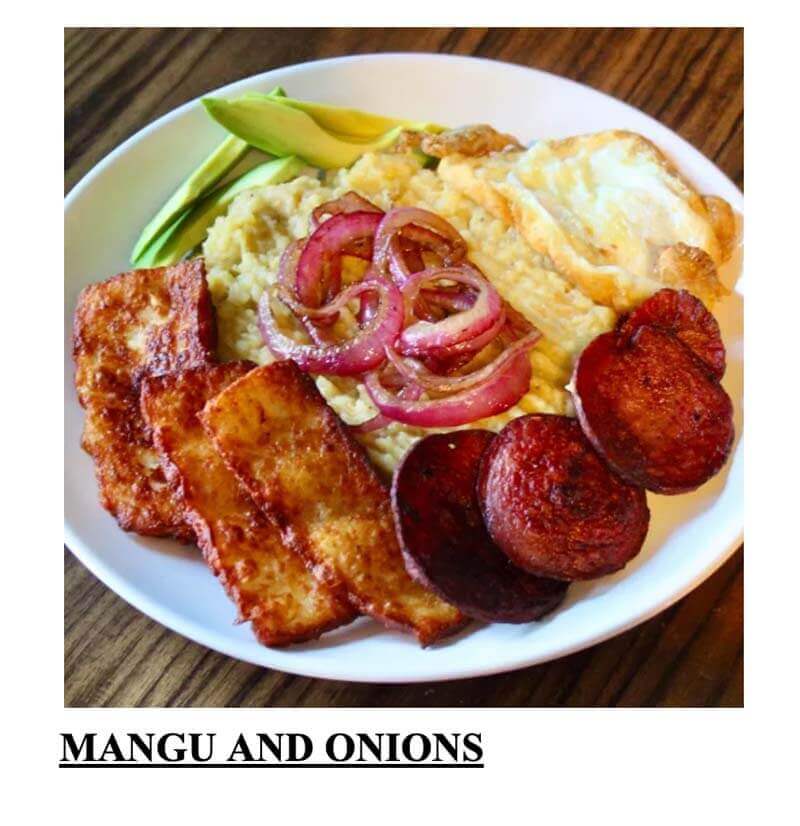
Among the recipes collected are Cinnamon rolls, Trinidadian Pelau, Caponata, Key lime pie, Saltfish Buljol, and Mangu.
On an online form, cooks shared “the recipes that reflect your family’s unique culture or heritage.” In a template, participants added the name of their recipe, ingredients, instructions, who and where it comes from, and answered “What experience do you associate with this dish?” The cookbook was to be printed and the recipes displayed outside Commons on December 2 and will also be available online so everyone can try these delicious recipes at home.
Among the recipes were Trinidadian Pelau submitted by Loren Bullen. The recipe, which includes onion powder, garlic powder, black pepper, oil, chicken, sugar, pigeon peas, thyme, carrots, a can of coconut milk, two cups of parboiled rice, and scotch bonnet pepper, is usually made by Bullen’s father. Ian Okore Frempong-Boadu ’26 shared the recipe for Saltfish Buljol, which his grandmother makes for big gatherings. Head of Technology Charles Polizano P’18 shared a recipe for a Sicilian side dish, Caponata, which his family has for Christmas Eve and Easter. The ingredient include eggplant, garlic, celery, red or orange peppers, crushed tomatoes, capers, and green olives.
“We hope Poly students will learn about the diversity at Poly and how we can connect as a community using something universal like food,” Auger-Dominguez concluded.
Destresser Spotify Playlist
For their project, Nate Hyman ‘26 and Simone Yoskowitz ‘25 created a collaborative Spotify playlist of songs suggested by students and faculty “to help with stress caused by school and school-related work.”
Yoskowitz explained, “We were talking about ways we like to de-stress, and realized music is a big one for both of us. Our plan is to have students come and write down their favorite destressing songs and artists. Then we’ll make the playlist on Spotify and Apple Music and send it to everyone.”
Hyman added, “Our idea came from our initial idea to help everyone at Poly deal with the overwhelming stress of work and overall school stress. We will go about creating the playlist by being in the Student Center with our board that we made that portrays an empty Spotify playlist. Students and faculty will be able to put their favorite destressing song on a slip of paper and place it in a jar. All of the (appropriate) songs will later be added to a real playlist and shared with the whole school. We will share the playlist with the whole school by asking Mr. Winston to email a link to everyone. We would each add our favorite calming song to our playlist.”
Coppola announced, “Here are the results of the collaborative Destresser Spotify Playlist conceived by Hyman and Yoskowitz and created by students and faculty to help with stress caused by school and school-related work. We hope it alleviates the stress you experience now or in the future!”
Ribbons and Gender Equality
Equity, acceptance, being together. These are just some of the words used to express their answer to answer one prompt: “What does gender equality mean to you?” in the project created by Milo Forman ’26 and Hutch Karp ‘26. Students chose a colored ribbon and a Sharpie which created a colorful and aspirational bulletin board.

Paper Recycling
With their project, Sebastian de Luque ’23 and Ben Hunter ‘23 tried to spread awareness and encourage participation in Poly’s paper recycling program. They invited others: “Come test your knowledge about paper recycling and then see how paper in the recycling bins can be transformed into art.”

“We decided to gather up existing paper recycling from the paper recycling bins Into one bin,” said Hunter. “Then, at the Student Center with the bins and a piece of poster paper, we asked students to choose one object from the paper recycling bin, decide whether or not that object was paper recyclable, attach a red or green piece of paper according to their decision (red meant no and green meant yes), and attach both the object and marking paper to the poster paper. This resulted in a layered and nuanced piece of art that was created by the community and draws attention to the issue of how to properly recycle paper.”
“Sebastian suggested that we focus on paper recycling because he had noticed that many members of the Poly community inaccurately recycle paper,” Hunter added. “I had taken Dr. Laungani’s Conservation class last year in which we talked in length about related issues, so I thought that paper recycling would be an important issue to encourage community involvement in. From there, we worked with each other and Ms. Coppola to finalize our project.”
“We found that students were eager to hear about our project because it seemed like an interesting and meaningful opportunity to both create a piece of artwork with other members of the community and learn interactively about how to recycle paper better.”

Some Art & Social Change projects like Mezuzah Stories and Umoja’s Post-Its took place in specific Affinity Spaces.
Mezuzah Stories
In Mezuzah Stories, Jack Rootenberg ’25 and Tyler Borg ‘26 invited the Upper School Jewish community to express themselves by writing about their heritage and about times they’ve felt empowered or disempowered at Poly because of their religion. These writings will be inserted into transparent mezuzahs and displayed in doorways throughout the school.
Umoja Post-Its
Through a series of writings and drawings on post-it notes, the project of Carlyle Muldrow ’26 and Bayo Maathey ‘26, Umoja Posts It, was meant to “bring awareness to other parts of our student body and help improve our experiences while also increasing the community’s awareness of Black students’ experiences at Poly.”
“The inspiration behind this project was to allow Black students in this community to show their emotions,” Muldrow said. “We thought that it would be a great idea if we collected different experiences from others in our DEIB group that have faced challenges because of their identities. We hope that students take away the idea that there are hard and good moments at Poly no matter who you are.”
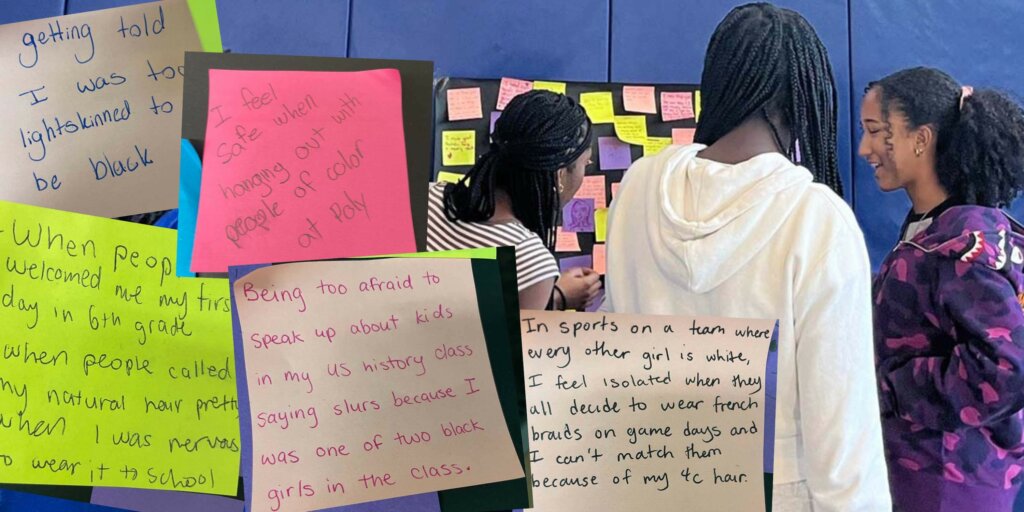
Stress Ball Project
Back in the Tower Gallery, the Stress Ball project by Abby Mangerson ’26 and Eden Golomb ‘26 helped people in the community to destress in a fun and interactive way. Through this project students could let go of stress by making stress balls out of balloons.
“We got more people than I expected would come, roughly 25, considering everyone has so much going on during school hours,” said Golomb. “When we first hung up the stress balls in the staircase a lot of students seemed confused and curious by the project. I stood there for a few minutes to see how people would react, and they seemed to be treating it respectfully.”
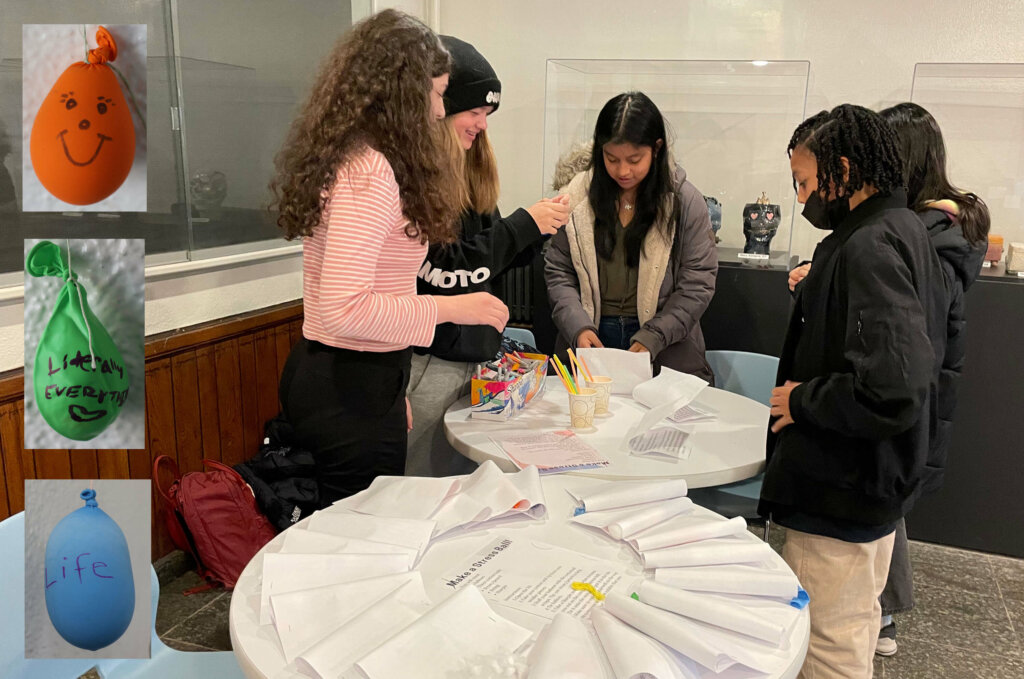
Golomb added, “I think that the people making the stress balls had a relief from stress because the activity distracted them from the pressures of school and grades. Also, when we hung up the balloons, people momentarily felt less stressed because they were excited to see something new around campus.”
“Our stress ball making project was community centered art,” Golomb explained. “People drew and wrote things on the balloons which is its own sort of art and by taking those balloons and hanging them up with different colored strings it makes it into an art installation.”
Piñata Busting
Some outdoor stress relief was also offered to students and faculty. Through Pinata Busting, hosted by Marco Dorazio ‘24 and Chris Pepperman ‘26, the community was invited to bash a piñata until it exploded. The piñata was filled with paper notes of positivity.
Before the outside event, Dorazio said, “I am hoping that students will respond to it positively. I want them to have fun hitting the piñata, but also for it to serve as a way for them to channel their feelings into a physical action, which is a pretty powerful thing.”

“I think this kind of art is different from what many people consider to be art,” he added. “It is not so much focused on the visual appeal of the artwork but more on the underlying meanings, actions, and emotions that the viewer has to undergo. I think that this is a work of art, but not in the sense that many people may think it to be.”
On a chilly Thursday morning, art students took turns whacking the round blue piñata hanging from a tree, and from their laughter, it seems the project was very successful at relieving stress.



